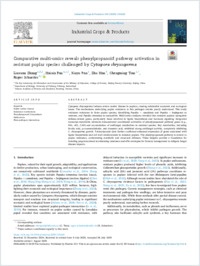Comparative multi-omics reveals phenylpropanoid pathway activation in resistant poplar species challenged by Cytospora chrysosperma
DOKPE
- Zhang, Linxuan University of Fribourg
- Fan, Haixia Yunnan Academy of Forestry and Grassland, Kunming, Yunnan, China
- Pan, Xinyu Beijing Forestry University, Beijing, China
- Han, Zhu University of Fribourg
- Tian, Chengming Beijing Forestry University, Beijing, China
- Schneiter, Roger ORCID University of Fribourg
- 2025
Published in:
- Industrial Crops and Products. - Elsevier BV. - 2025, vol. 234, p. 1-12
Poplar canker disease
Resistance mechanisms
Phenylpropanoid biosynthesis
Multi-omics
Plant-pathogen interactions
English
Cytospora chrysosperma induces severe canker disease in poplars, causing substantial economic and ecological losses. The mechanisms underlying poplar resistance to this pathogen remain poorly understood. This study evaluates resistance in three poplar species, identifying Populus × canadensis and Populus × beijingensis as resistant, and Populus tomentosa as susceptible. Multi-omics analyses revealed that resistant poplars upregulate defense-related genes, particularly those involved in lignin biosynthesis and hormone signaling. Integrated transcript-metabolite networks demonstrated coordinated activation of phenylpropanoid pathway genes (e.g., PAL, 4CL, CAD) and accumulation of antifungal metabolites in resistant species. Key metabolites, including ferulic acid, p-coumaraldehyde, and cinnamic acid, exhibited strong antifungal activity, completely inhibiting C. chrysosperma growth. Transcriptomic data further confirmed enhanced expression of genes associated with lignin biosynthesis and cell wall reinforcement in resistant poplars. The phenylpropanoid pathway is central to poplar resistance, orchestrating metabolic and structural defenses. These insights provide a foundation for breeding programs aimed at enhancing resistance and offer strategies for forestry management to mitigate fungal disease impacts.
- Faculty
- Faculté des sciences et de médecine
- Department
- Département de Biologie
- Language
-
- English
- Classification
- Biology, life sciences
- License
- Open access status
- green
- Identifiers
-
- DOI 10.1016/j.indcrop.2025.121620
- ISSN 0926-6690
- ISSN 1872-633X
- Persistent URL
- https://folia.unifr.ch/unifr/documents/332489
Other files
Statistics
Document views: 55
File downloads:
- 1-s2.0-s0926669025011665-main: 58
- 1-s2.0-s0926669025011665-mmc1: 20

